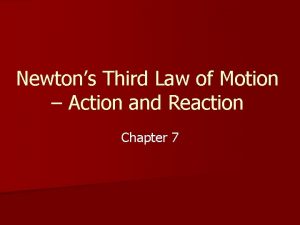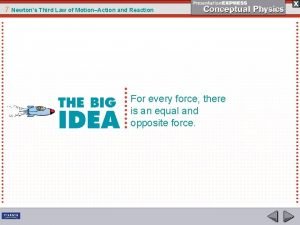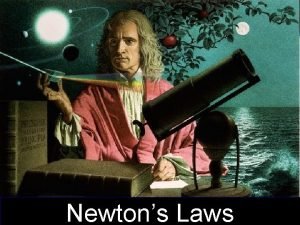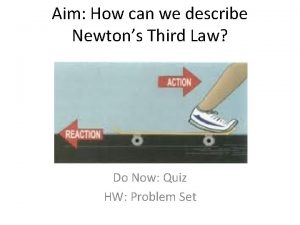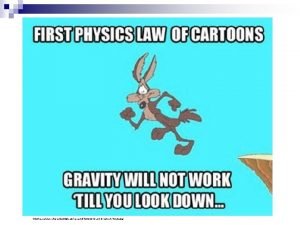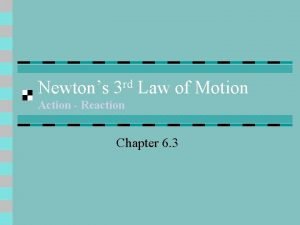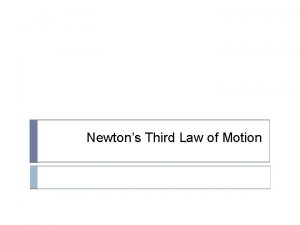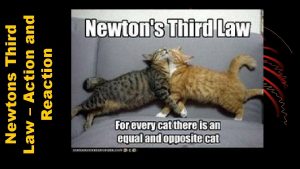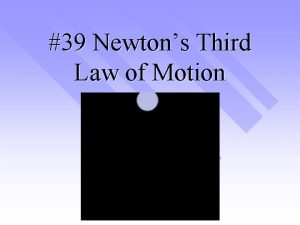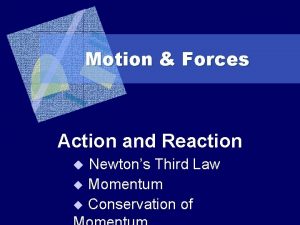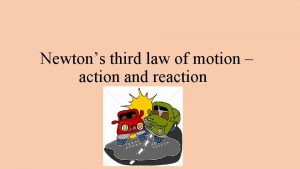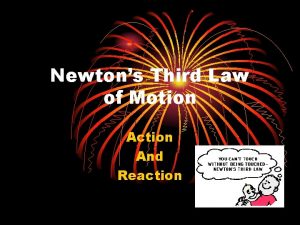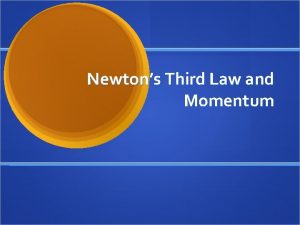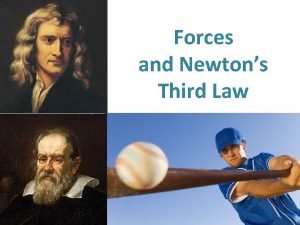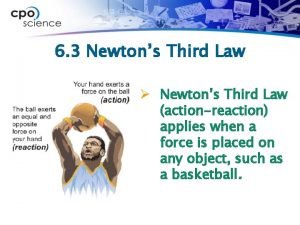Newtons Third Law of Motion Action Reaction Newtons















- Slides: 15

Newton’s Third Law of Motion

Action - Reaction • Newton’s first two laws of motion explain how the motion of a single object changes. • Newton’s third law describes something else that happens when one object exerts a force on another object. • According to Newton’s third law of motion, forces always act in equal but opposite pairs.

Action - Reaction • The forces exerted by two objects on each other are often called an action-reaction force pair. • Either force can be considered the action force or the reaction force. • Action and reaction force pairs don’t cancel because they act on different objects.

Newton’s Third Law • Newton’s Third Law of Motion states: for every action, there is an equal but opposite reaction. • This means that when you push on a wall, the wall pushes back on you with a force equal in strength to the force you exerted.

Action - Reaction • You constantly use actionreaction force pairs as you move about. • When you jump, you push down on the ground. • The ground then pushes up on you. It is this upward force that pushes you into the air.

Action - Reaction • When the rocket fuel is ignited, a hot gas is produced. • As the gas molecules collide with the inside engine walls, the walls exert a force that pushes them out of the bottom of the engine.

Action - Reaction • This downward push is the action force. • The reaction force is the upward push on the rocket engine by the gas molecules. • This is the thrust that propels the rocket upward.

Question 1 Explain Newton’s third law of motion. Answer The third law says that forces always act in equal but opposite pairs. For every action, there is an equal and opposite reaction.

Question 2 If they are “equal but opposite, ” why don’t action-reaction pairs cancel? Answer Action-reaction pairs don’t cancel because they act on different objects, not on the same object. Equal and opposite forces acting on the same object would cancel.

Think about it. . . What happens if you are standing on a skateboard or a slippery floor and push against a wall? You slide in the opposite direction (away from the wall), because you pushed on the wall but the wall pushed back on you with equal and opposite force. Why does it hurt so much when you stub your toe? When your toe exerts a force on a rock, the rock exerts an equal force back on your toe. The harder you hit your toe against it, the more force the rock exerts back on your toe (and the more your toe hurts).

Newton’s Third Law l l A bug with a mass of 5 grams flies into the windshield of a moving 1000 kg bus. Which will have the most force? The bug on the bus The bus on the bug

Newton’s Third Law l The force would be the same. l Force (bug)= m x A l Force (bus)= M x a Think I look bad? You should see the other guy!

Consider hitting a baseball with a bat. If we call the force applied to the ball by the bat the action force, identify the reaction force. (a) the force applied to the bat by the hands (b) the force applied to the bat by the ball (c) the force the ball carries with it in flight (d) the centrifugal force in the swing

Review Newton’s First Law: Objects in motion tend to stay in motion and objects at rest tend to stay at rest unless acted upon by an unbalanced force. Newton’s Second Law: Force equals mass times acceleration (F = ma). Newton’s Third Law: For every action there is an equal and opposite reaction.

1 stlaw: Homer is large and has much mass, therefore he has much inertia. Friction and gravity oppose his motion. 2 nd law: Homer’s mass x 9. 8 m/s/s equals his weight, which is a force. 3 rd law: Homer pushes against the ground and it pushes back.
 According to the third law of motion action and reaction
According to the third law of motion action and reaction Law of motion 3rd
Law of motion 3rd Newtons third law of motion
Newtons third law of motion Newtons third law of motion
Newtons third law of motion Newtons third law of motion
Newtons third law of motion Cosa afferma la legge di gravitazione universale
Cosa afferma la legge di gravitazione universale Newton's first law and second law and third law
Newton's first law and second law and third law Newton's first law and second law and third law
Newton's first law and second law and third law Describe newtons third law
Describe newtons third law Law of thermodynamics in chemistry
Law of thermodynamics in chemistry Law of newton
Law of newton Newtons 3 rd law of motion
Newtons 3 rd law of motion Newtons 3 rd law of motion
Newtons 3 rd law of motion Newtons 3 rd law of motion
Newtons 3 rd law of motion Newton's 1st law meme
Newton's 1st law meme Newtons 3 rd law of motion
Newtons 3 rd law of motion
